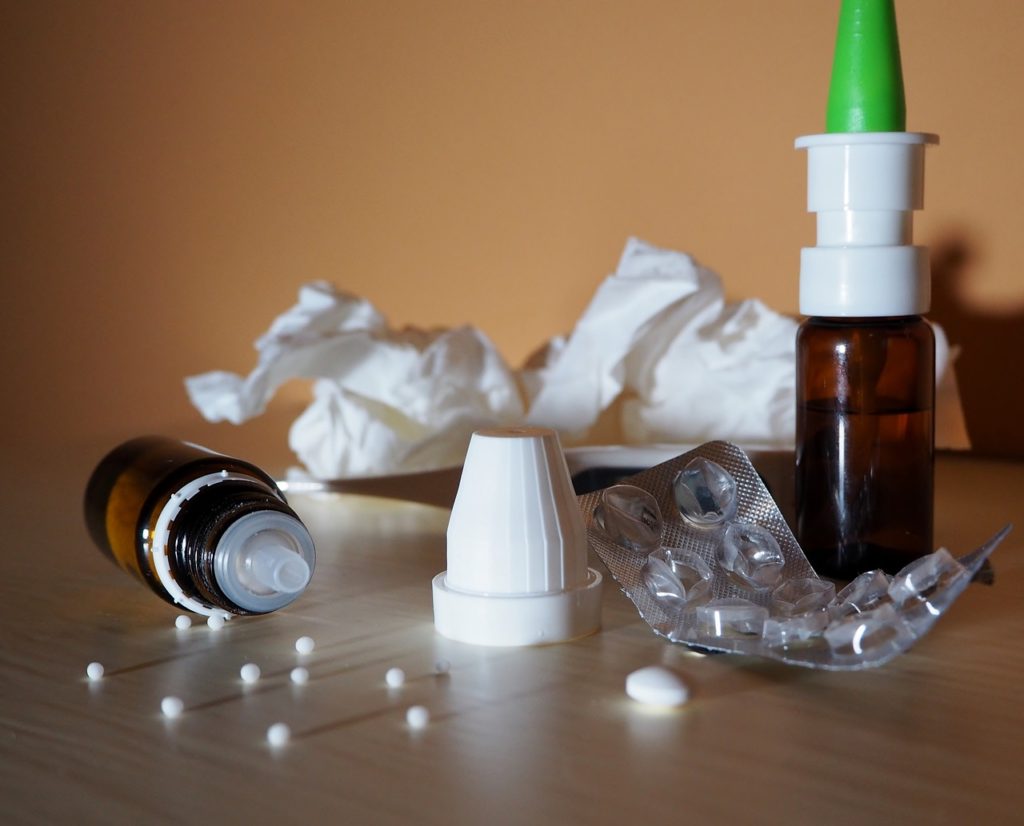
–by Dr. Peng E. Wang
Introduction
Allergies theories have a long history, commonly known as seasonal allergies, hay fever, or allergic rhinitis. The phrase hay fever is not an accurate description, as early investigations in the 1800s thought allergies were due to the smell of new hay (Wiki). Allergy is technically the reaction between an antibody and an antigen, which can be from pollen, dust, mold, and inoculations of vaccines (NATGeo). The result is the breakage of mast cells which leads to mucus production, and swollen leaky arteries. There is an increase in seasonal allergies because it’s being recognized more, and their prevalence is increasing (NCBI). You may be asking how you can get rid of allergies. Allergy is the physical process of your immune system in constant flux with your environment; it’s a part of your defense mechanism. You cannot remove your immune system because that would be incompatible with life. However, you can learn how to manage your seasonal allergies. This article discusses the best way to do that.

1. Avoidance
No medication is usually the best medicine. The initial approach to allergies is the diagnosis so you know what you are allergic to and when and where these allergens are around you. In addition to diagnosing your specific allergies, follow these general recommendations.
- Shut windows and doors during the high pollen season
- Minimize central ventilation by turning down your furnace or air condition units
- Use a high-quality furnace filter (HEPA)
- Change your furnace filter more frequently during high pollen season (6-12 weeks)
- Change your bedding and pillowcases more often (weekly)
- Regularly launder your outer layer clothing (jackets, hats)
- Consider using an air purifier in your room
- Consider wearing a mask, nowadays it’s much less of a novelty
While these recommendations may suggest total avoidance, you cannot avoid all allergens, nor do you want to. When you think about it, exposure to allergens and pathogens is the process of your immune system learning your environment. Like computer systems and artificial intelligence, your immune system constantly surveys the surrounding environment, and there will be false alarms (allergies). Although you want to minimize your exposure to pollen, it’s not always possible. You have to function through your workdays and not be locked up indoors, so let us look at some treatment options available to minimize your symptoms.
Related article: 5 Seasonal Allergies Symptoms
2. Topical steroids
Instead of taking an oral medication first, topical steroid is the first line of choice to manage allergies. This class of medicine directly reduces inflammation of your nasal cavities, sinuses, and other parts of your airway (larynx, bronchus) topically. There are various forms of topical steroids, mainly sprayed and inhaled. Eye steroids (ophthalmic) are not routinely recommended unless it’s from your eye doctor.
Common Nasal topicals; over-the-counter or by prescription
- Flonase, the active ingredient is fluticasone propionate, slow onset, alcohol-based solution
- Nasacort, the active ingredient is mometasone, slow onset, non-alcohol based solution (less likely to cause nosebleed)
- Veramyst, the active ingredient is fluticasone furoate, discontinued
Common Ophthalmic (eye) topicals prescribed only for good reasons
- Durezol, the active ingredient is difluprednate
- Lotemax, the active ingredient is ioteprednold
- Many more variants exist and it all depends on your ophthalmologist’s preference and insurance
Inhaled topicals are good options for allergic cough
Prescriptions only
Singular agent ICS (inhaled corticosteroid)
Advantage: less expensive
- Fluticasone, known as Flovent, the powder form was discontinued; aerosol (HFA) available
- Mometasone, known as Asthmanex; aerosol (HFA) and Twisthaler (powder)
- Budesonide, known as Pulmicort; aerosol (HFA) or nebulized only
Multi-agent ICS (inhaled corticosteroid)
Advantage: no need for the addition of albuterol, but more expensive (brand mostly)
- Advair Diskus, fluticasone/salmeterol; with a long-acting form of albuterol, twice daily
- AirDuo Respiclick, fluticasone/salmeterol; same as Advair but has a generic, less expensive, twice-daily
- Breo Ellipta, fluticasone/vilanterol; only once daily, expensive
- Symbicort HFA, budesonide/formoterol, aerosol only
- Wixela, fluticasone/salmeterol; same as Advair, but has generic, less expensive, twice daily
Using topical steroids routinely can lead to side effects. Specifically, nasal steroids cause rebound congestion due to their vasoconstrictive properties, so they are best used as needed. If you are finding yourself using these medications daily to stay symptom-free, please stop because topical steroids may be the culprit of your symptoms. Avoid using steroid eyedrops without your eye doctor’s approval because they can increase your eye’s pressure (intraocular pressure), which is unsafe. Use other allergy meds instead for the eyes. Think of steroids as the after-the-fact treatment for allergies; the inflammation has already occurred. They are also useful for colds.
Related article: 5 Common Causes of Cough
3. Antihistamines type 1
Antihistamines reduce allergy symptoms by reducing the cascading effects of the inflammatory pathways due to mast cell effects, including arterial dilation (vasodilation) and leakage (permeability) of the arteries (Wiki). Available in various forms.
Over-the-counter or prescribed
Taken by mouth (oral), tablet or liquid
Second-generation (non-drowsy)
- Claritin, the active ingredient is loratadine, lasts 24 hours
- Clarinex, the active ingredient is desloratadine, an analog of Claritin, fewer side effects, and lasts 24 hours
- Zyrtec, the active ingredient is cetirizine, taken on an empty stomach, and lasts 24 hours
- Xyzal, the active ingredient is levocetirizine, an analog of Zyrtec, with fewer side effects and lasts 24 hours
- Allegra, the active ingredient is fexofenadine, SLOW onset, not great for colds, last 24 hours
First-generation (more drowsy)
- Benadryl, the active ingredient is diphenhydramine, quick onset but does not last 24 hours (<10 hours)
- ChlorTrimeton, the active ingredient is chlorpheniramine, less drowsing but only lasts 4 hours
Nasal sprays
- Astepro, the active ingredient is azelastine
Eyedrops
- Optivar, the active ingredient is azelastine
Antihistamines, a great invention to manage allergy symptoms since the 1940s. Initial management of allergy symptoms required avoidance without available medication. Reducing the histamine response reduces mucus production and swelling of the arteries inside the sinuses, thus less congestion and runny nose. While antihistamines minimize symptoms of allergies, your immune system is still recognizing the allergens and adapting, similar to immunotherapy (allergy shots), therefore you should not aim for total avoidance of allergens. Think of antihistamines as the before-the-fact treatment; they prevent further inflammation from occurring.
4. Anticholinergic (Ach)
This class of medications works by reducing congestion and mucus production, by targeting the mucus cells (Wiki).
Prescription required
- Atrovent nasal spray, the active ingredient is ipratropium
Over-the-counter
- Optivar eyedrops, the active ingredient is ipratropium ophthalmic
Think of Atrovent as after-the-fact allergy management as inflammation has already occurred. They only target the mucus cells by reducing their stimulation, thus, they are not just for allergies-induced runny noses (allergic rhinitis). They are also useful for non-allergic rhinitis, such as temperature and infectious nasal congestion and drainage.
5. Stabilizers
This class of medication stabilizes the mast cells so they do not break (degranulate), thus less ongoing inflammation (Wiki). The result is less swelling of the sinuses and less mucus production.
Over-the-counter
- NasalCrom, the active ingredient is cromolyn sodium
Prescription required
- Crolom, the active ingredient is cromolyn sodium
Although less commonly used, these are available as additional therapies for severe allergies. Notably, the eyedrop form is prescribed only because other eye diseases can cause excessive tearing and itching, not just allergies. Your eye doctor should conduct an eye exam to ensure another disease is not causing your eye symptoms. Think of these drugs as after-the-fact allergy management since the cell signals already occurred.
Conclusion
Seasonal allergies carry a heavy burden on our society due to the productivity cost (NCBI). Controlling allergy symptoms can improve your productivity while your immune system continues to adapt to your environment. Initially, you should consider an allergy test to determine what you are most allergic to, although it’s not always possible due to healthcare access shortages. When you are having allergy symptoms it’s best to start with a topical steroid first, then add on an antihistamine type 1 as an ongoing treatment during your allergy season. Antihistamines reduce further escalation of the allergic response at the tissue level, thus it’s before-the-fact treatment so it needs to be scheduled. Topical steroids reduce inflammation after the allergic response has already occurred, you start with this because your allergies may only last a day or two. If it lasts longer then you add the likes of Claritin or Zyrtec, and use Flonase as needed since it can cause nosebleeds and rebound congestion if scheduled.
Bonus: Decongestants, why you should avoid it
Can decongestants make you drain more and have more congestion? Yes. The mechanism is more open airway by compressing the arteries lining the airway, thus allowing more space for drainage and more stomach upsets. Decongestants also cause rebound congestion, with elevated heart rate and blood pressure to a dangerous level. The difference between a vein and an artery is the amount of smooth muscle they are made of. Arteries have three layers of smooth muscle, and veins only have one. Veins are more elastic and compliant. Arteries are not very compressible. If you forcibly squeeze arteries by using decongestants, rebound congestion ensues. Bottles of nasal decongestants, such as Afrin (oxymetazoline), and others like phenylephrine in cold remedies, it’s best to avoid it.

Related article: 5 Seasonal Allergy Symptoms